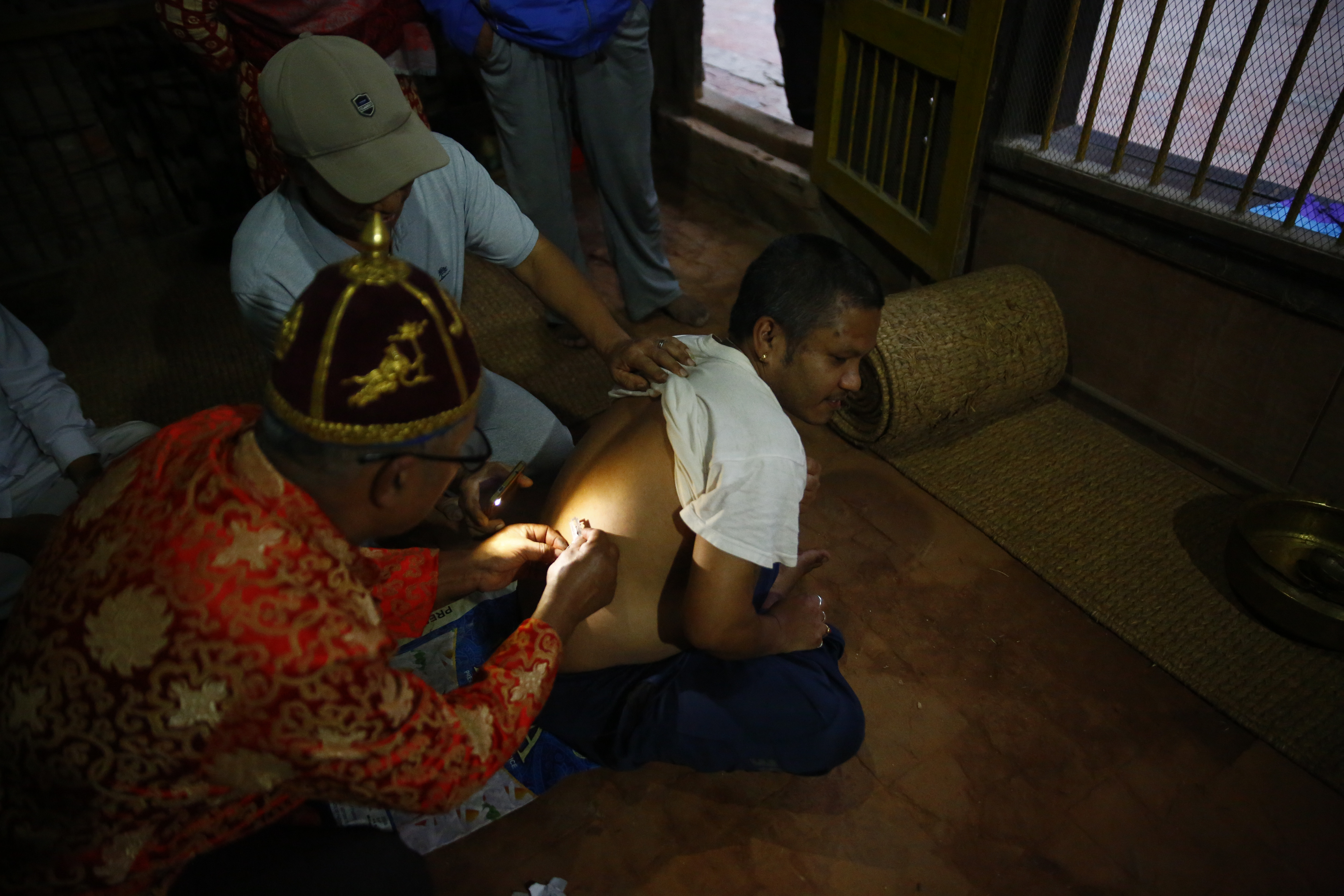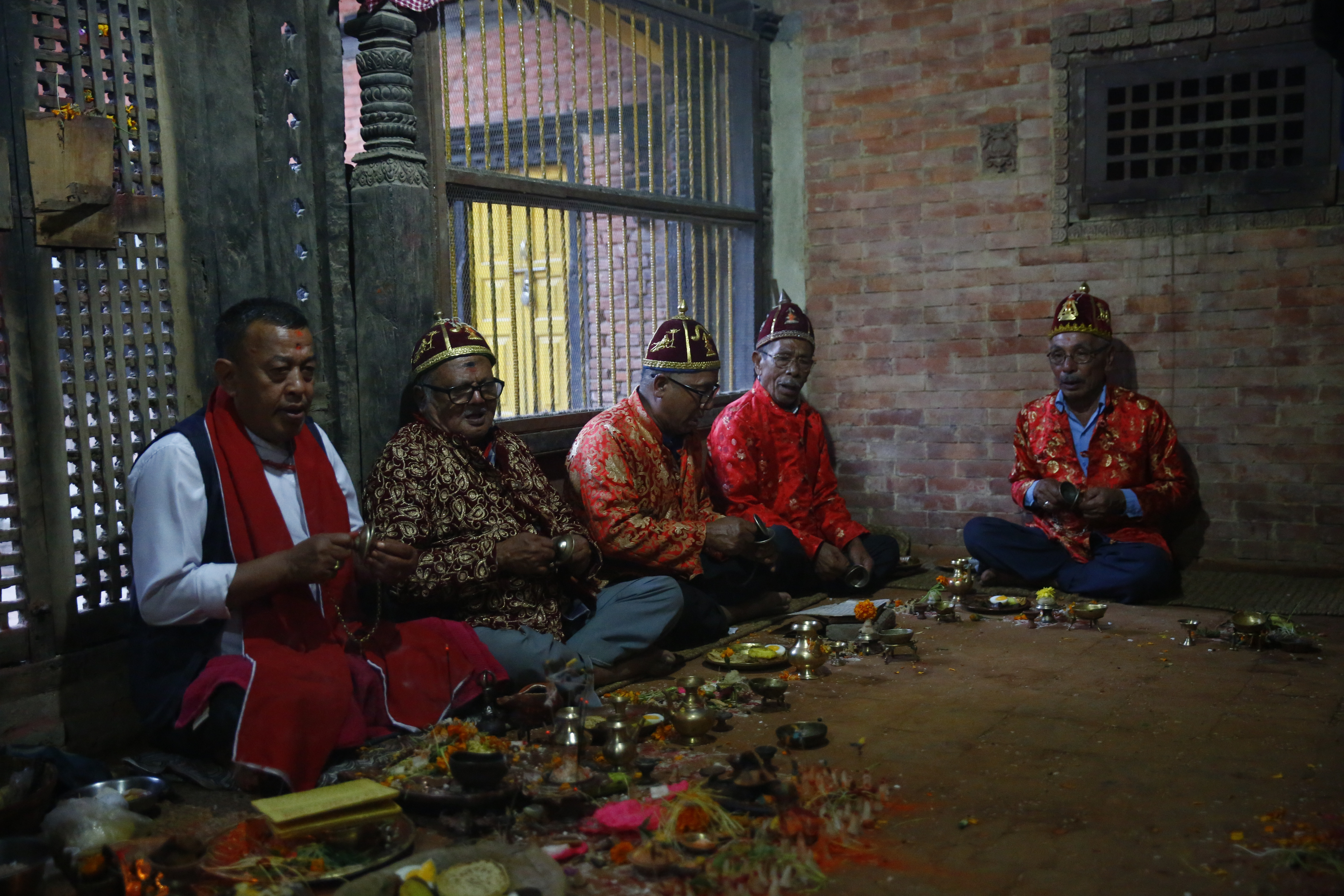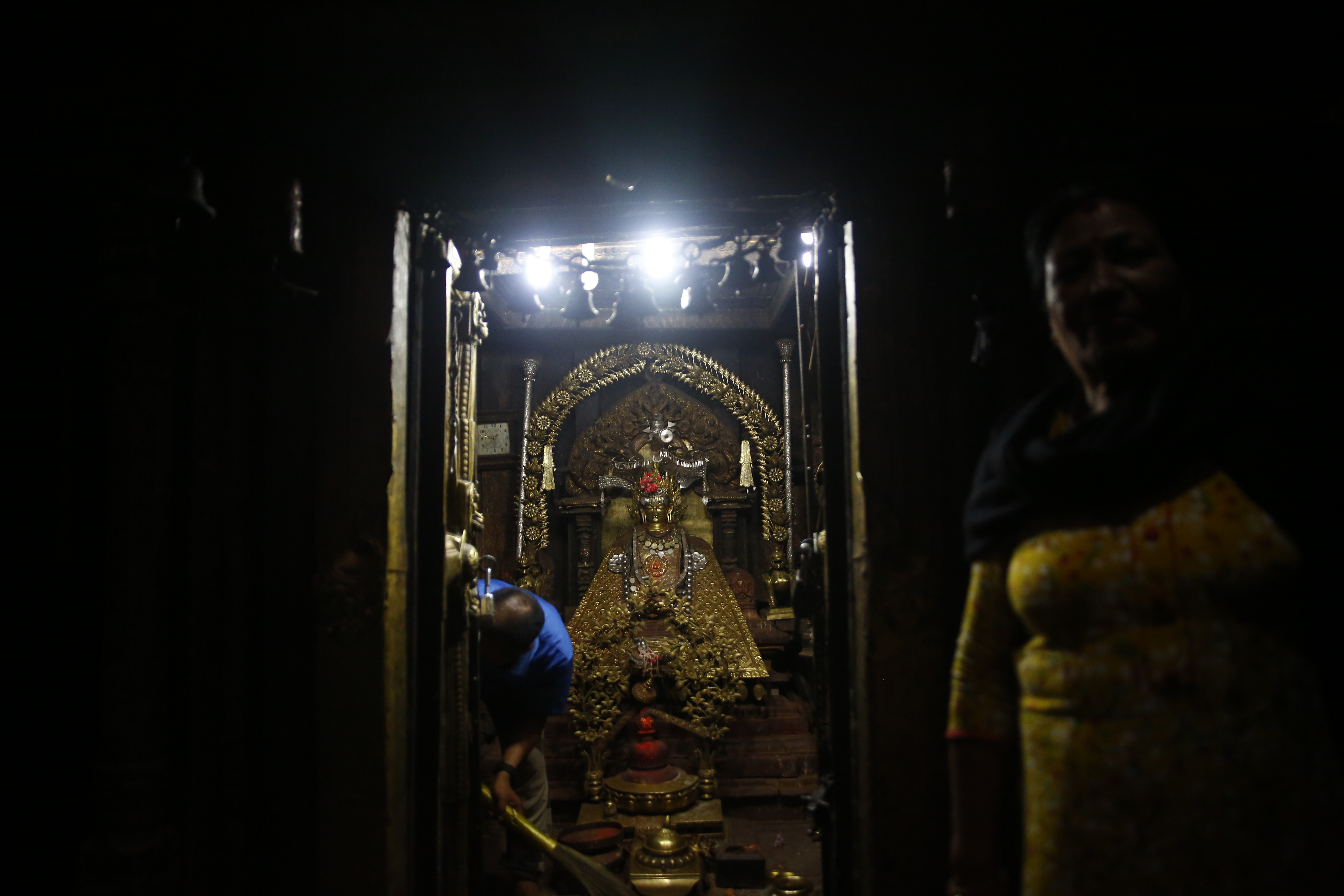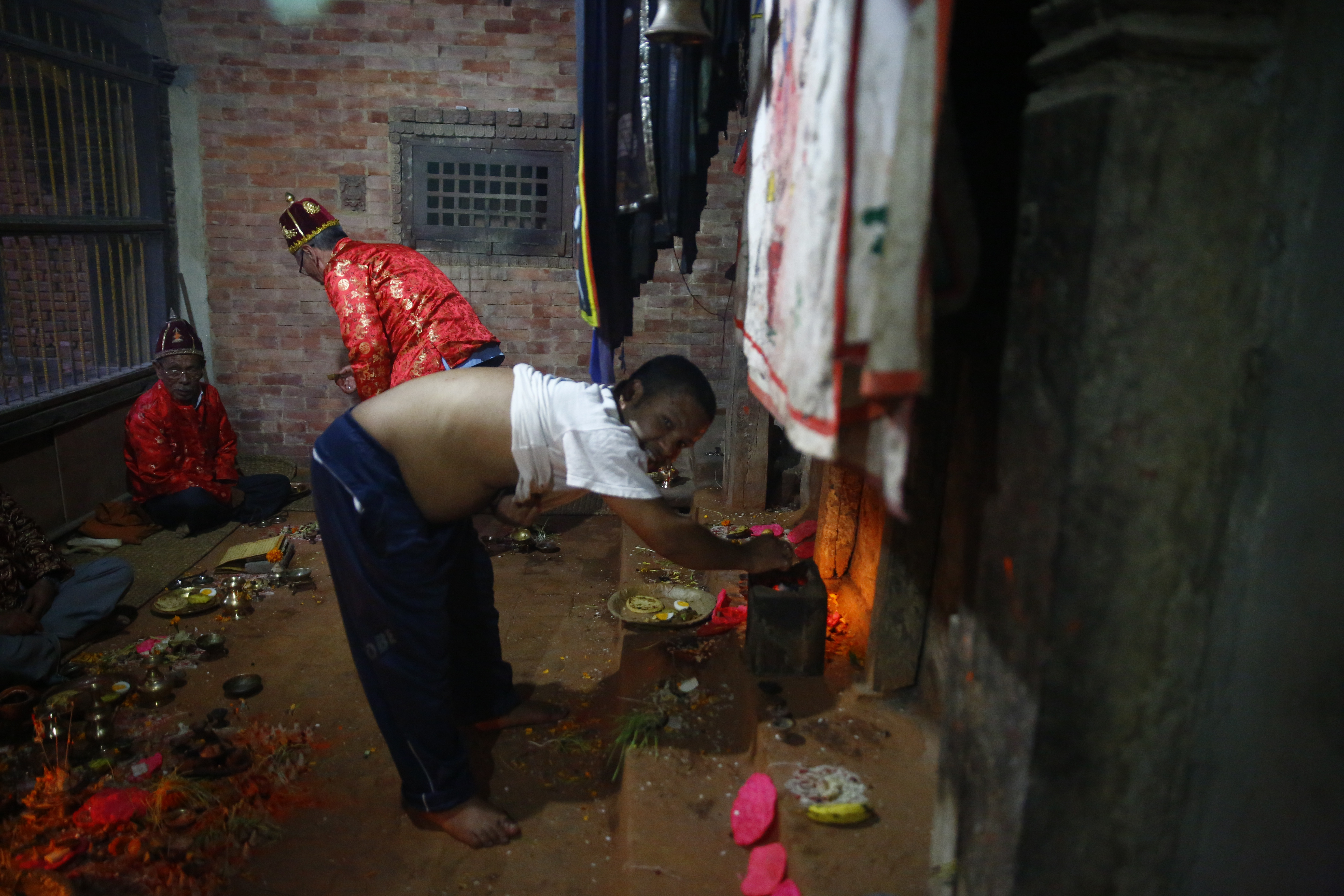Making Peace with the Ghouls
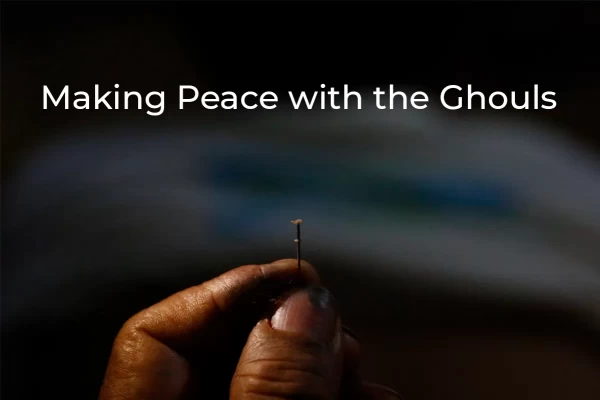
In the mystical valley of Kathmandu, one can come across thousands of stories. Each corner of the city holds a secret, a tale of a legend, you only need to find the person willing to share them with you. These ancient tales are intertwined with the supernatural which dates back to hundreds or even thousands of years. From stories about goblins coming out at night to eat children to friendly ghouls who reside in homes and consider themselves as part of the family, old tales are abundant in Kathmandu.
Many of the city’s religious traditions, festivities, and rituals have resulted from long-held beliefs that are as old as the city itself. Although many such traditions have faded over time, few of them have been able to survive in this day and age. One such is the tradition of “La Dhenyu” literally translated to “slicing the skin” which takes place in Jaya Manohar Mahavihar in Subahal, Patan.
Every year, during the day of Navami in Dashain, devotees gather along with five high priests to make offerings of their flesh and blood to the fearsome god, Mahankal. It is carried out as a peace offering to the bloodthirsty spirits that reside here. This ritual contrasts sharply with its surroundings. The Jaya Manohar Mahavihar is a Buddhist temple located inside a ‘bahal’. A ‘bahal’ is a square courtyard that houses a ‘bihar’ which is a shrine for the Shakyamuni Buddha and its caretakers. Although bahals are commonly found in the cities of Kathmandu valley, you wouldn’t see bloodshed happening in a Buddhist courtyard. So how did this paradoxical ritual come to be in this bihar? To understand exactly why this tradition is carried out, we need to dive into the history regarding the origin of Subahal and the Jaya Manohar Mahavihar.
A unique tradition of offering human flesh to please the spirits.
The Great Fire
The story starts with fire. About 900 years ago, during the time of old kings, a great conflagration burned down an entire neighborhood in a place known as Bishalnagar, close to modern-day Naxal. The fire was so big that it had burned down several houses and also temples. After the fire, the people were left homeless and without the means to rebuild. Then came a divine intervention in the form of an eagle. This eagle is said to have flown over the city of Lalitpur to find a new location for the temple that was destroyed in the fire. The mystic eagle happened to land at Subahal and then burst into flames. When the then king heard of this, he announced that the bihar should be established in the location where the eagle has landed. Thus, the Subahal courtyard came to be. However, the place had previously been a crematory. Nevertheless, the bahal was constructed. It is said that the spirits which resided around the crematory began haunting the local residents.
“Spirits that reside around cremation areas thirst for human flesh and blood,” says Suba Ratna Shakya, a local resident and the current president of the Jaya Manohar Mahavihar committee. “It is said that these spirits of the crematory require human sacrifice and can even have the power to take away human lives. As a result, in order to make peace with the spirits and to keep them from disturbing the living, a Mahankal shrine was created and the “La Dhenyu” tradition was started.” he adds.
The Human Flesh Offering
The ritual goes like this: during Nawami, five eldest priests from the bihar gather together to chant prayers while the ceremony happens. Then the devotees line up to make their offerings. One by one, the devotees get ready to offer a piece of their flesh. “The flesh offered can only be cut from the upper body part, above the navel,” explains Shakya
“We cut off only a small piece of skin from the devotee’s body.” continues Shakya, “We pierce the skin with a needle and pull it, then the skin is neatly sliced off with a blade and placed into a holy fire as an offering to the god, Mahankal and the spirits”. In Buddhism and Hinduism, Mahankal is believed to be the governor of death and time. The statues and images of Mahankal can often be spotted at the sides of entrances to temples, placed there for protection. This deity is also believed to protect the living from demons and evil spirits. If you look at the traditional Buddhist paintings of the Mahankal, you will see that he stands on top of corpses, has skulls embedded in his crown, and uses a human skull as a bowl. The Mahankal’s shrine located within the bahal is believed to be a very powerful one. Thus, it is covered with several layers of curtains that are painted with elaborate symbols and are dyed dark blue, the hue that represents the deity.
We pierce the skin with a needle and pull it, then the skin is neatly sliced off with a blade and placed into a holy fire as an offering to the god, Mahankal and the spirits
Suba Ratna Shakya, Priest
The tattered and faded curtains placed at the very bottom of these layered curtains seem to be as old as the deity’s shrine itself. “Nobody is allowed to see what is behind those curtains. It is said that if you peek behind the curtain, you will either go blind or lose your life altogether,” says Shakya. Thus, the Mahakal at the Jaya Manohar Mahavihar is much revered by the believers. There are many devotees who believe in the local tradition. It is believed that if you are suffering from an illness somewhere in the body, and if you offer the flesh from that part, your illness gets cured. Unlike other traditions that are bound within a certain clan or religion, this ritual is open to anyone who is willing. “In the past only males used to participate, however, now, many women come to make offerings as well.”
However, this year, due to the ongoing pandemic, the number of offerers has been limited to only one. Up until last year, many devotees would show up to contribute to the ritual. In the previous years, almost 20 to 30 devotees would willingly line up to contribute their flesh. The elder priests would be chanting long into the night as one of the younger priests helps to retrieve the offering from devotees one by one. “This ritual is open to everyone, but we need to take precautions this year, so we’ll only be offering flesh from one local to complete the ritual,” explains Shakya.
When asked why this ritual takes place only once a year during Nawami, Shakya replies, “It is the most significant time of the year.”. In Hinduism, Navami is considered to be a very auspicious day as it is the day good won over evil. This day also has significance in astrology and many followers of different sects of Hinduism perform specific rituals during this day.
If you visit Jaya Manohar Mahavihar, after entering, you will find yourself standing right in front of the main Buddha temple. You will see a rectangular formation of bricks on the ground, right in the center of the bahal representing the cremation area which this bahal was built over. But even so, you will naturally turn your head to the left where you will spot the dark shrine of Mahankal. The place where an unusual ritual takes place to keep evil spirits in check and bring peace to its local residents.

